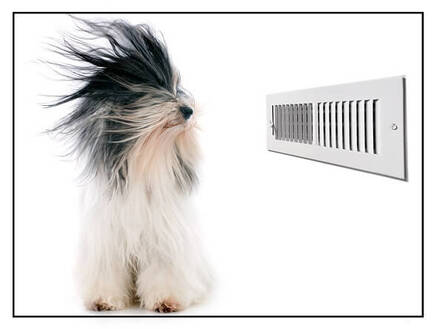|
Your HVAC system relies on good air flow to work its magic: heating, cooling, and ventilating your home. When your furnace is choked with dirt, your flue blocked with animal nesting, or your dryer vent clogged with lint, these systems are hindered. At best the associated system loses efficiency, at worst you risk a house fire or the backup of toxic gases into your home Let's take a look at how proper air flow affects the smooth functioning of each of the HVAC (Heating, Ventilation, and Air Conditioning) systems. We'll include the dryer venting system here, though not strictly considered part of the HVAC system. (It does feature a vent, after all, and serves to exhaust heated air outdoors.) Air flow creates draft in your chimney Your chimney relies on the process of draft to maintain combustion and to safely vent its byproducts from your home. This includes not only your fireplace flue but your furnace, water heater, and boiler flues as well. Via the process of draft, warm air and the smoke or gases it carries from the source of combustion, moves up through the flue and is exhausted outside the house, often onto the roof. Any kind of blockage or other hindrance will impede air flow and prevent draft. Without draft, of course, the necessary sequence of events will not unfold, at which point back-drafting can occur. In the case of a fireplace chimney, this will result in smoke coming back into the home rather than exiting the chimney. In the case of a utility flue (furnace, etc.), this will result in toxic gases, such as carbon monoxide, backing up dangerously into your living space. Air flow carries warm air and lint away from your dryer As your clothes dryer spins and fluffs and dries, the hot air generated by the machine is pushed out the back of the unit and through the dryer vent line, where it safely exhausts outside. Over time, as tiny bits of lint are deposited within the vent line, air flow slowly becomes restricted. Restricted air flow begets restricted air flow; that is, the more lint that is deposited, the more air flow is restricted, in turn leading to more buildup, until air flow is choked off completely by a dryer vent clog. Once a dryer vent clog has formed and air does not flow freely, several things can happen. The best-case scenario is that your dryer's efficiency is reduced and takes longer to dry clothes, or it simply shuts down. The worst-case scenario is that the heat, having no escape, builds up inside the vent line and ignites the lint, causing a fire. For this reason, no dryer vent cleaning job is considered complete until good air flow has been observed from the outside exhaust vent. Air flow through the air conditioner's A-coil transfers heat Your A-coil, or evaporator coil, is one of the indoor components of your air conditioning system. Its function, by way of a series of refrigerant-filled tubes, is to absorb heat, thus cooling your indoor air in the summer. The exterior of the A-coil consists of a series of small, tightly spaced fins that help this process. Because these fins usher air toward the coil, when they are dirty or clogged the entire process is interrupted. But the ill effects of poor air flow through the A-coil are not limited to your air conditioning system. Because all air that circulates through the HVAC system passes through the A-coil—whether it is your furnace or the AC that's running—a clogged evaporator coil has the potential to hamper not only the cooling of your home but its heating as well, and to drive up utility bills. Dirty components equal restricted air flow equals reduced efficiency equals higher energy costs. You get the picture. Air flow through the furnace generates heat Your furnace's job is to pull air from the return air ducts, warm it, and push the warmed air out through the supply ducts into your living space. Proper air flow is of course critical to this process, from beginning to end and back around again. Here are some points at which it is especially vital.
Maintain proper air flow with HVAC system cleaning If you've read this far you probably don't need convincing that proper air flow is critical to the smooth functioning of your HVAC system. Any hindrance to adequate air flow in the form of dirt or debris can create havoc and lead to equipment breakdowns. HVAC cleaning calls into action an arsenal of specialized tools (rotary brushes, air snakes, tentacled air whips, high-pressured air triggers, industrial vacuums) and technician expertise to rid the system of component-clogging dirt and debris. The result is a system that functions more smoothly and efficiently, performing its task in less time and using less energy to do so. Just as our lungs and respiratory systems need unobstructed, smooth intake and exhalation of air to function as they should, so must our HVAC systems be able to "breathe" freely in order to do their best work for us. Wanna dig deeper? Explore our HVAC cleaning service pages, including a detailed description of the cleaning process and tools utilized for each system. View HVAC Cleaning Services Many thanks to our technician Roy S. for lending his expertise to this article.
0 Comments
Your comment will be posted after it is approved.
Leave a Reply. |
SearchArchives
April 2022
|
Twin Cities Furnace Cleaning - Open 7 Days a Week 8AM to 8PM

